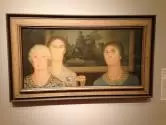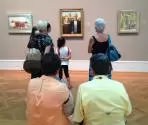A $300 Masterpiece

After getting lucky last week in Cincinnati and literally stumbling upon this Grant Wood satiric oil painting “Daughters of Revolution” in the city’s art museum, I made my way north to Chicago.
No luck was involved with this next planned stop.
In 1930 the 39-year-old Grant Wood was still a struggling, unknown artist searching for his own style and personal identity. He had earlier begun what once was a promising career as an Arts and Crafts silversmith, studying under Ernest Bachelder at the Minneapolis School of Design and Handicraft, before being hired as a silversmith at the famed Kalo Shops in Chicago. In 1914 he and fellow silversmith Christopher Haga struck out on their own, forming the Volund Silver Shop not far away. Wood’s involvement was short-lived, however, as he returned to his home town of Cedar Rapids by 1916 to pursue a career as a painter.
For nearly a decade Grant Wood painted in the impressionist style, traveling to Europe and imitating the great masters, producing dozens of plein aire paintings of French cottages and blurry landscapes, but impressing virtually no one. Again he returned to Cedar Rapids, broke and discouraged, but still determined to succeed.
In 1930 he persuaded his sister Nan and his local dentist to serve as models for what would become one of America’s most iconic paintings – “American Gothic.” Now considered the Midwest’s version of “Whistler’s Mother” or the “Mona Lisa,” Grant Wood’s portrait of this Iowa father and daughter was entered in the Art Institute of Chicago’s annual contest. According to the terms of the contest, the artists agreed that should their work be selected, they would receive a pre-determined payment from the Art Institute for their work of art.
For “American Gothic,” Grant Wood received a check for just $300.
But he got a million dollars worth of publicity.
He was applauded, and he was scorned. His work was heralded, and it was parodied.
And the same still applies.

Today, “American Gothic” is one of many great paintings on display in the second floor gallery at the Chicago Art Institute. It shares wall space with masterpieces by Edward Hopper, Jackson Pollock, Pablo Picasso, Marc Chagall, Winslow Homer, and James Whistler, yet when I turned the corner and stepped into the room, I knew exactly where to head.
To the crowd that is always gathered in front of “American Gothic.”
It draws us like a magnet.
Is it the father’s stern, uncompromising facial expression, or his tight grip on the handle of a sharpened, three-pronged pitchfork – all the while wearing a suit coat over a pair of bib overalls?
Or it is his daughter’s downcast eyes, hiding, perhaps, some family secret kept behind the shaded windows in the background?
Eighty-five years later, the debate still rages, and the painting still remains the single most discussed and viewed portrait in the Art Institute’s collection.
And we still come to stare, to study, and to ask the questions no one will ever be able to answer.
But as John Keats penned:
“Beauty is truth, and truth beauty, – that is all
Ye know on earth, and all ye need to know.”

Until next Monday,
Pause to take a fresh look at some old art.
Bruce
